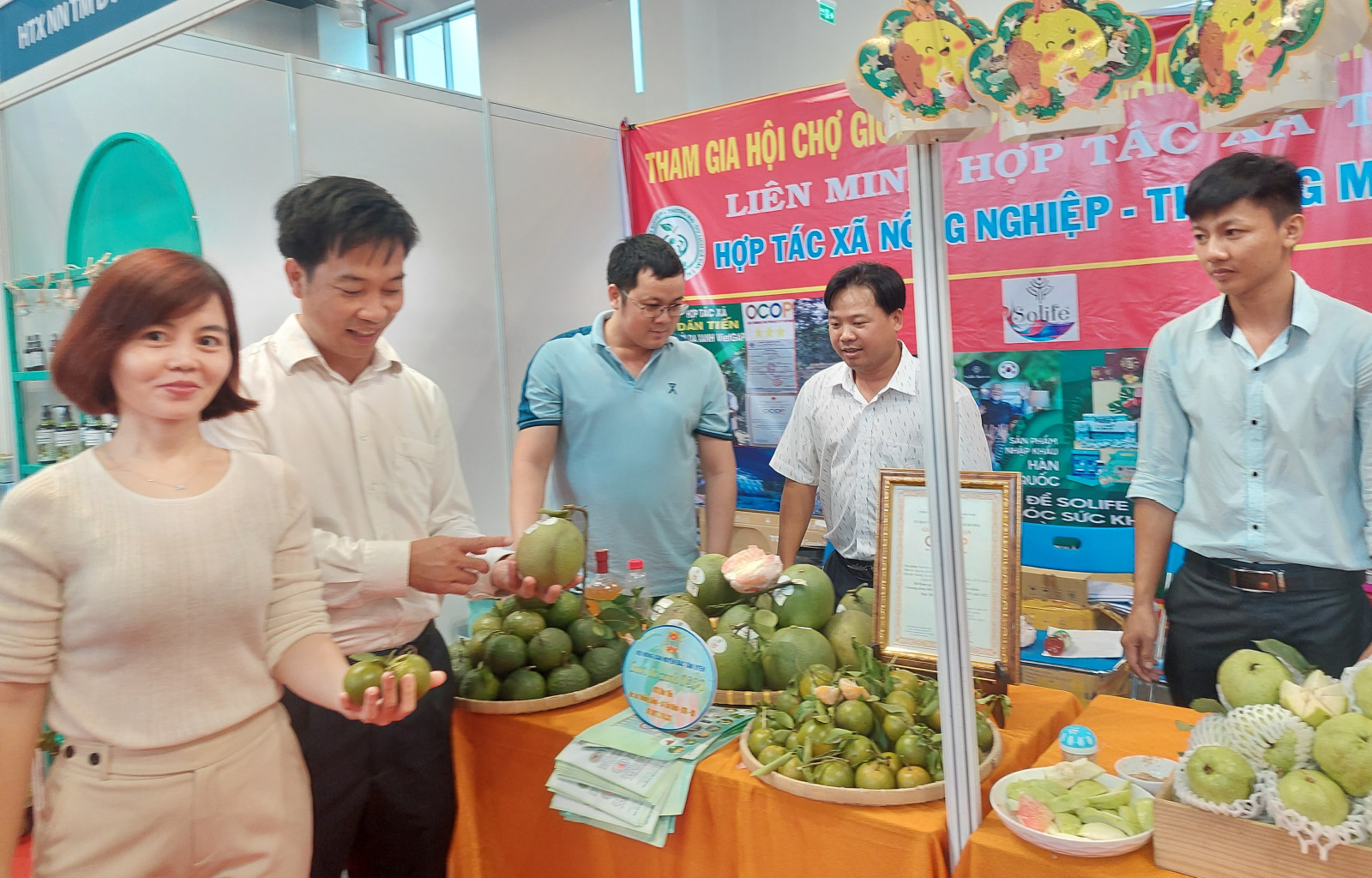Agricultural production restructured and diversified
In 2023, the agricultural sector still faced numerous challenges due to the impact of climate change, livestock and poultry diseases with potential risks of recurrence, low prices of livestock products, and many households and farms not being able to restock. However, under the strong guidance of the Government, provincial People's Committees, and the entire agricultural sector, proactive management and operation of agricultural production in the province have still achieved promising results.

The OCOP program in Binh Duong province has achieved many positive results. In the photo: OCOPs participating in the Conference on Connecting Supply and Demand of Goods in the Southeast region - Binh Duong 2023.
Production maintained
In 2023, according to the leadership of the Department of Agriculture and Rural Development, the agricultural and rural development sector will continue to effectively implement comprehensive restructuring plans and synchronized strategies. The focus will be on operating in accordance with market mechanisms, applying new scientific and technological advancements as the main driving force for value creation and transitioning to a new growth model and the organization of production and business chains in agriculture continues to be innovated, the quality of agricultural products improved, and the competitiveness of agricultural commodities having made significant progress. On the other hand, the sector has effectively implemented disease prevention measures for crops and livestock; livestock farming has shown positive changes towards concentration.
Accordingly, the value of agricultural, forestry, and fisheries production in 2023 will increase by more than 3% compared to 2022. The coverage rate of forestry and perennial crops will be maintained at 57.5%. The agricultural structure will become more substantial, efficient, and the scale of production will be enhanced, shifting towards commodity production based on leveraging the advantages of each region. Until now, the area of annual crop cultivation has reached nearly 20,000 hectares, the area of perennial crops has reached 142,300 hectares, and the area of high-tech application in agriculture is about 7,116 hectares, increasing by 2.6% with valuable crops such as vegetables, mushrooms, fruit trees, orchids, and ornamental plants.
In recent years, urban agriculture in the province has seen significant development, primarily concentrated in the cities and towns in the southern region of the province. Many models with distinctive features of urban agriculture have achieved high efficiency in terms of socio-economic and environmental aspects. By the end of 2023, the total area of urban agriculture models for cultivation is expected to reach over 964 hectares.
In the livestock sector, the industry continues to implement measures to maintain 13 disease-free zones and safe facilities for avian influenza, feline leukemia, foot-and-mouth disease in livestock, swine fever, and rabies in dogs and cats. In the province, there are currently 165 recognized animal husbandry facilities that are considered safe from animal diseases. Among them, 50 facilities are safe for livestock, accounting for approximately 19% of high-tech livestock farms, while 115 facilities are safe for poultry, accounting for approximately 57% of high-tech livestock farms.
The One Commune One Product (OCOP) program is a key for the economic development of rural areas, aiming to unleash internal potential and increase value. It is a crucial solution and task in the implementation of the new rural development phase from 2021 to 2025, which aims for depth and sustainability. The OCOP program of the province has achieved many positive results. So far, the program has recognized 126 OCOPs out of 60 entities, of which 10 products have met the 4-star standard.
Toward smart new rural areas
The reality has shown that various levels, sectors, and localities have made concerted efforts to implement programs in line with economic and social development plans, harmoniously integrated with the urban development trajectory of the province and districts, towns, and cities. Investment in developing important infrastructure such as transportation, electricity, water, healthcare, education, and culture has significantly facilitated connectivity and narrowed the gap between urban centers and rural areas in the province. Various innovative and effective approaches have demonstrated their practical value and contributed to driving the construction of new rural areas. Binh Duong has achieved 100% of its communes meeting the criteria for new rural areas, with 38 out of 39 communes reaching the advanced new rural area standards, accounting for 97%. Additionally, 3 out of 6 district-level units have been recognized for meeting the criteria for new rural areas or completing the tasks of building new rural areas.
Mr. Pham Van Bong, Director of the Department of Agriculture and Rural Development, stated that Binh Duong is an industrial province with a rapid pace of urbanization and mechanical population growth. The construction of new rural areas is defined as a starting point without an endpoint, with the ultimate goal of improving the material and spiritual lives of rural residents and narrowing the gap with urban areas. Binh Duong province aims to have 100% of its communes meet the new rural area standards by 2025, with 10 communes achieving exemplary new rural area status (accounting for 24% of communes meeting the advanced new rural area standards). Additionally, all districts are expected to meet the new rural area standards, and Binh Duong province will fulfill its mission of constructing new rural areas.
With the goal of developing urban agriculture in various forms and promoting sustainable value chains, the agricultural sector and rural development will continue to drive the restructuring process towards diversifying urban agricultural production, combining traditional agriculture with high-tech agriculture, and producing safe products. This will contribute to increasing productivity and quality, as well as linking production with the consumer market. Agriculture in the province continues to develop in line with scientific and technological advancements in agricultural production. The agricultural economic structure is shifting towards urban agriculture development, high-tech agricultural applications, production of high-value and efficient goods, ensuring food safety, and increasing the proportion of the livestock sector in the overall agricultural structure of the province.
Reported by Thoai Phuong – Translated by Vi Bao

